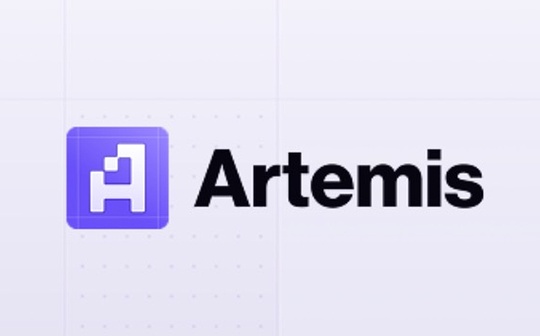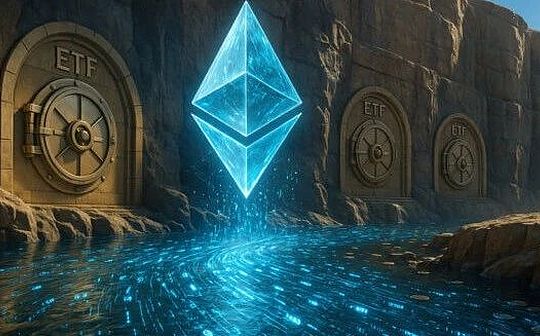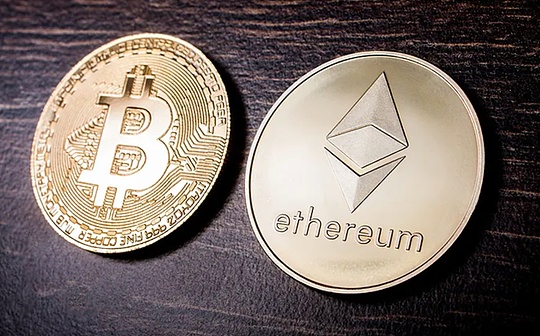
source:Trend Research
Since ETH enters this round of upward cycle, every short-term fluctuation adjustment, the market will begin to spread the data of ETH de-staking.However, from the perspective of supply and demand relationship, the demand generated by the current institutional consensus is far greater than the supply of de-pled, and we believe that the long-term full-load de-pled situation is not sustainable.Since the treasury company represented by SharpLink began to buy, the U.S. stock company holding ETH has held nearly US$20 billion in ETH, accounting for 3.39% of the total supply. Among them, Bitmine is still 75% away from achieving its goal of 5% of the total ETH.The further implementation of crypto-friendly policies in the future and Wall Street’s long-term value of ETH has formed a consensus. The “rush-up” of ETH has just begun. With the coming of interest rate cut cycle, we will raise the long-term ETH target price, believing that the ETH market value will surpass BTC in 1-2 bull and bear cycles.
1. Unstaked data
Since the Ethereum Pectra (Prague+Electra) main network upgrade took effect in May 2025, the theoretical exit rate of pledge is priced according to the ETH quantity and is hard-plated to 256 ETH/epoch (1 epoch≈6.4 minutes).Convert to day, that is, the theoretical upper limit is 256 × (1440 ÷ 6.4) = 256 × 225 = 57,600 ETH/day.
Since July 18, the destaking situation of the ETH main network has been in a full load queue. Currently (August 24), there are 873,849 ETHs waiting for destaking, which takes 15 days and 4 hours to digest.
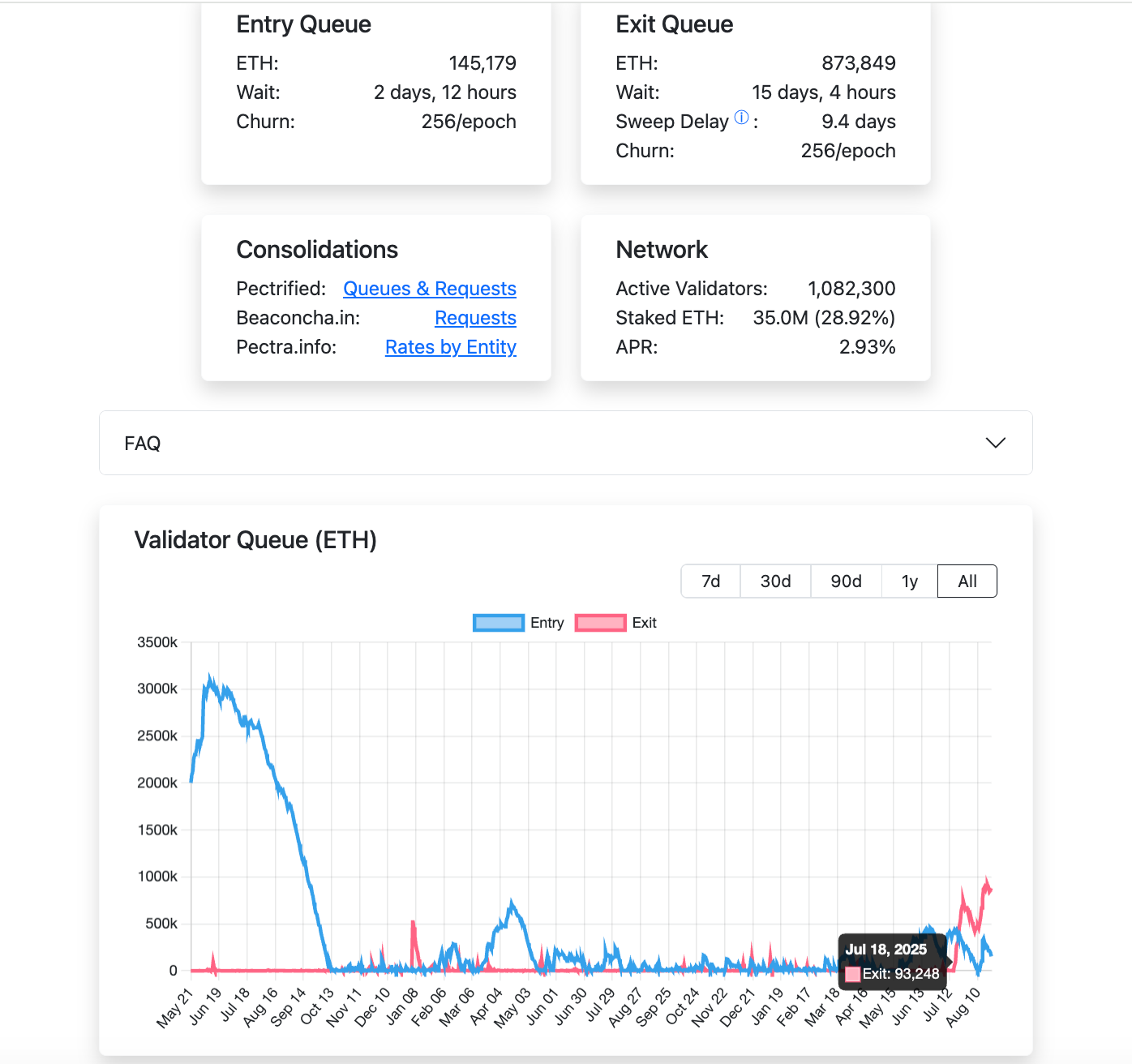
There is an upper limit on the number of ETH depleted pledges in one week, with the maximum being 57,600*7=403,200 ETH. Last week, ETH treasure company bought 531,400 pieces. While the treasure company remained in the buying state, even if 100% of the depleted pledge part entered circulation, it can be completely digested.We believe that the network value of ETH is not fully recognized by the market at present, and the destaking ETH does not fully enter circulation. As the consensus is further formed, the destaking in the full-load state will also improve.
Simply put, de-pending does not represent the complete market supply situation. Although the total amount of de-pending shows a certain negative correlation as the price of ETH rises, we believe that the supply in this part will not dominate ETH into a market from rising to falling.
2. Analysis of demand of treasury companies and ETFs
Since June 2025, ETH treasury companies represented by SharpLink have begun to enter the market, which confirms our previous speculation that the United States has adopted ETH as the primary base for new infrastructure on financial chains (see our “Specific content” on June 11 and July 3Written on the eve of the surge, why are we optimistic about ETH》, 《The storm is coming, and the market will promote ETH to realize value discovery》).The entry of institutional-level purchasing power represented by Caikuan Company has fundamentally changed the dominant force of ETH price fluctuations.

1. The operation logic of the treasury company – the growth of the treasury is the premium
The market premium (MNAV) of cryptocurrency treasury companies comes from investors’ recognition of their buying assets’ growth potential.DAT companies increase their holdings of crypto assets through financing (stock additional issuance or debt), forming a flywheel effect: more crypto assets → balance sheet expansion → stock price rise → more financing capabilities → further increase holdings.This cycle amplifies the market’s optimistic expectations for coin hoarding stocks and drives MNAV premiums.This flywheel effect is confirmed by the success of micro-strategy companies, and ETH has some characteristics that are more suitable for treasury assets than BTC.
2. What are the differences between ETH treasury companies – Assets come with their own income
Unlike BTC’s buying scarce limited assets, ETH, as the largest DeFi network in the crypto world, will naturally generate returns on scale holdings.
(1) Pledge income: Ethereum has shifted to the PoS mechanism since its “merger” in 2022, giving ETH interest-generating asset attributes. At the same time, its ecosystem supports high-yield activities such as DeFi and RWA.These characteristics provide a stable source of cash flow for DAT, forming the basis of “cash flow premium”.As of August 2025, the total pledge of Ethereum reached 36 million ETH, accounting for 30% of the total supply, with an average annualized rate of return of about 2.95% (the actual rate of return is about 1.5%-2.15%).1.5% risk-free return, similar to the cash flow of traditional bonds.
(2) Liquidity income: Obtain additional income by providing liquidity in the Ethereum ecosystem by providing liquidity.In 2025, the Ethereum DeFi protocol TVL will be approximately US$120 billion, and the annualized yield of liquidity mining is usually between 2–10%.Assuming that coin stocks provide liquidity through the DeFi protocol, it is conservatively estimated that an annualized return of 3.5%.Comprehensive pledge income (1.5%) and liquidity income (3.5%), and coin stocks can realize an annualized cash flow income of about 5%.Using the discounted cash flow (DCF) model, assuming the discount rate is 5%, the cash flow premium is 1 times MNAV, that is, the total MNAV multiple is 2 times.
(3) Other premiums: Ethereum’s EIP-1559 mechanism makes ETH potential deflationary characteristics by destroying the underlying transaction fees.In 2025, Ethereum expects to issue a net additional 730,000 ETH (annual inflation rate is about 0.6%), but with the destruction of the network.If ETH achieves net deflation in the future, the ETH price may only rise above and increase the cash flow returns of coin stocks, indirectly increasing the MNAV premium.
3. The buying volume of the treasury company has just begun
ETH treasury companies with BMNR and SBET have high purchase costs and sufficient back-up efforts. The overall buying volume of traditional finance is still in the startup stage.According to data summarized by Embers, BitMine (BMNR) has reserved 1,523,373 ETH from July 9, with a cost of $5.68 billion and an average price of 3,730 ETH, while SharpLink (SBET) has reserved 740,760 ETH from June 13, with a cost of $2.57 billion and an average price of 3,478 ETH, including 1,388 ETH rewards obtained through staking.As Ethereum prices continue to rise, the holding costs of the two companies will increase accordingly.

From the perspective of future financing capabilities:
BMNR: According to Prospectus Supplement released on August 12, 2025, BMNR has increased the total ATM amount to US$24.5 billion, and is expected to raise approximately US$4.45 billion through the ATM mechanism, holding approximately 1.52 million ETH, and in theory there are still approximately US$18 billion to US$20 billion available.If the ETH price is calculated at US$4,700 per coin, BMNR can increase its holdings by approximately 4.26 million ETH, bringing its potential total holding cap to close to 5.78 million ETH, close to the target of 5% of the total holding.
SBET:SharpLink has quickly accumulated about 740,760 ETH through ATM financing (cumulatively approximately US$1.2 billion) and registered direct sales.After adjustment, its ATM cap has been increased from the initial amount to a maximum of US$6 billion. In addition, it is expected to obtain approximately US$600 million through targeted share issuances and other methods.Assuming that the financing is all used to purchase ETH, based on the ETH cost, it is estimated that the remaining ATM balance can be purchased with 851,000 ETH.
At present, the U.S. stock company holding ETH has held nearly US$20 billion in ETH, accounting for 3.39% of the total supply, of which Bitmine is still 75% away from achieving its goal of 5% of the total ETH.
Funds available for daily ATMs:
MicroStrategy is a representative of Bitcoin treasury strategies, and its trading volume varies significantly in bull and bear markets.
MicroStrategy implemented a Bitcoin treasury strategy in 2020. During the 2020-2021 bull market, its stock price has risen from $13 to the highest to $540, with daily trading volume increasing significantly, but it is greatly affected by market activity and BTC prices.According to recent stock prices and average trading volume, the daily trading volume is approximately US$3.5 billion to US$7 billion.
During the 2022 bear market, the price of Bitcoin plummeted from $69,000 to $16,000, MicroStrategy’s stock price halved, trading volume shrank significantly, and the average daily trading volume dropped to $200 million to $500 million.
Compared with ETH DAT companies, similar situations may occur:
BitMine’s current trading volume has reached US$2 billion per day, reaching a maximum of US$6 billion, which is close to or exceeding the peak of MicroStrategy’s last bull market and has attracted high attention from the market.SBET currently has a large daily trading volume, with an average of 50 million shares and a daily trading volume of about US$1 billion.If the market enters a bear market, DAT’s trading volume may shrink to $100 million to $500 million per day, similar to MicroStrategy’s performance in 2022.Assuming that 10%-20% of the daily trading volume can be converted into ATM, then in the case of current trading volume, US$2 billion-4 billion can be raised to purchase ETH every week. According to the ATM ceiling, it is expected to last for 3 months.
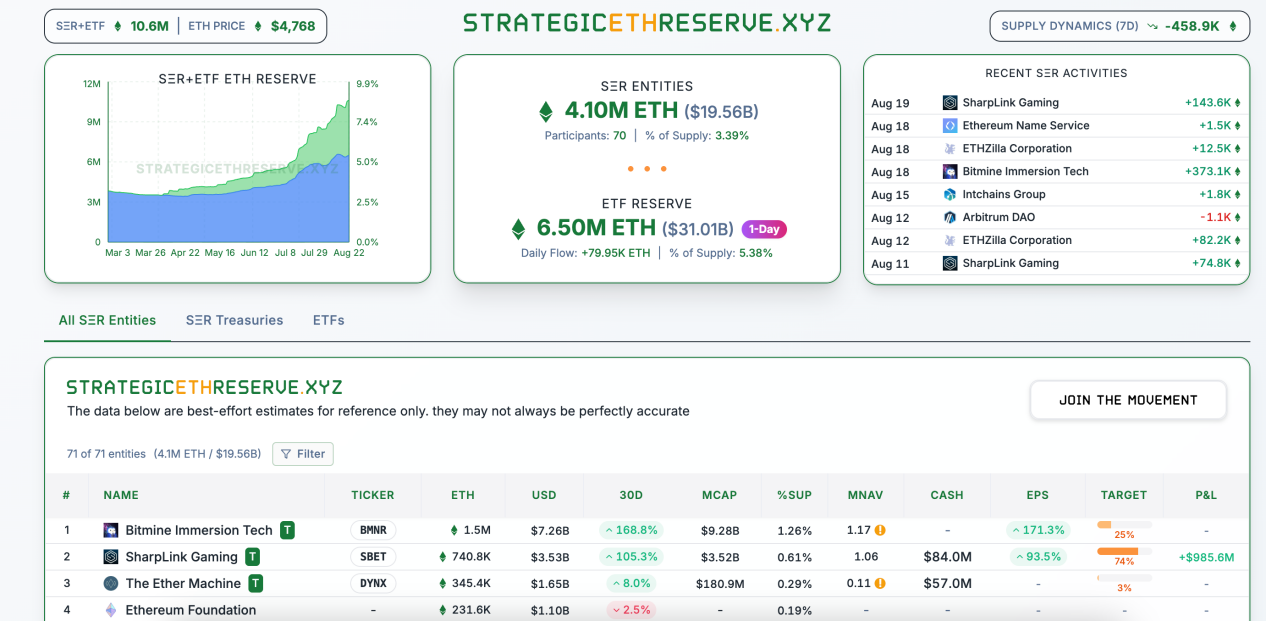
4. The long-term performance of ETFs remains strong
As a passive fund that has achieved success at large-scale and low-cost, ETFs have become the first choice for traditional large-scale fund allocation.From May 16 to August 15, the ETH ETF set a record of 14 consecutive weeks of net inflows, with a maximum of US$2.85 billion in a single week, with net asset value accounting for 5.38% of the total supply. Among them, 19.2 billion worth (68%) of ETH was accumulated over the past 14 weeks, and the comprehensive buying cost is estimated to be around US$3,600.
BlackRock’s ETHA is the largest ETF, holding about 2.93% of the tokens and currently has a market value of US$17.2 billion.Since April 2025, ETHA has been in a net inflow every week, with net inflows of approximately US$8 billion and a maximum net inflow of US$2.32 billion.
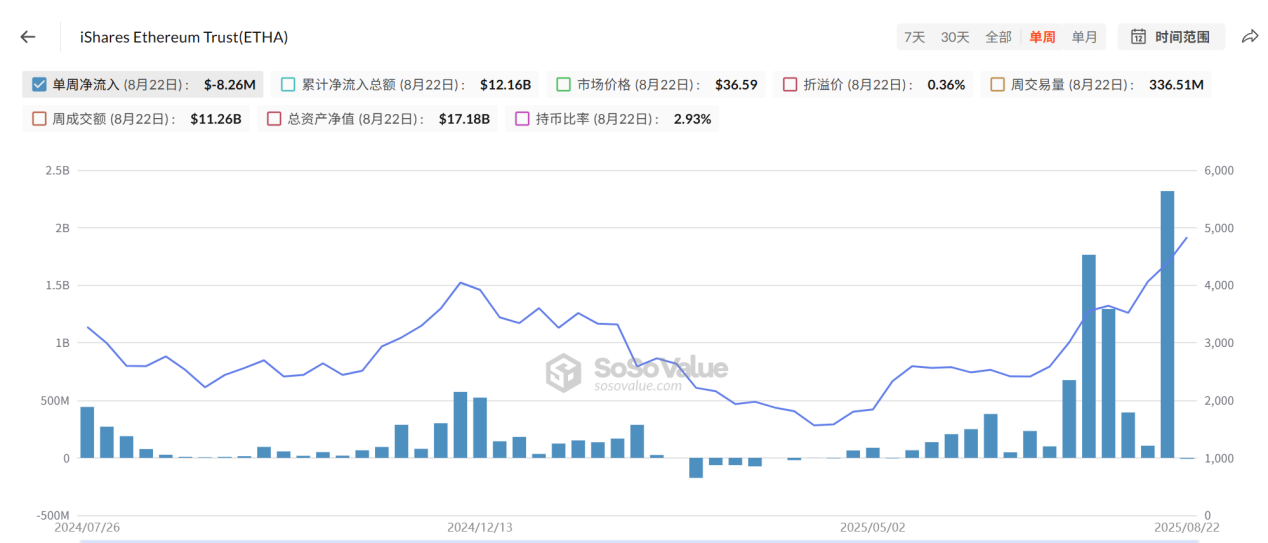
Currently, the scale of global gold ETFs (total ETFs/ETPs in various places) is US$386 billion, Bitcoin is US$179.5 billion, while Ethereum is only US$32.6 billion. If the Ethereum narrative is sustainable, it will take a stake of US$140 billion to tie the current Bitcoin ETF scale.
5. The market trend shifts from BTC to ETH trading
Judging from the contract holdings and trading volume, BTC has cooled down significantly and funds flowed into ETH in a concentrated manner.In early May, the share of BTC contract holdings accounted for 73%, but currently only 55%; the share of ETH holdings increased from 27% to 45%.
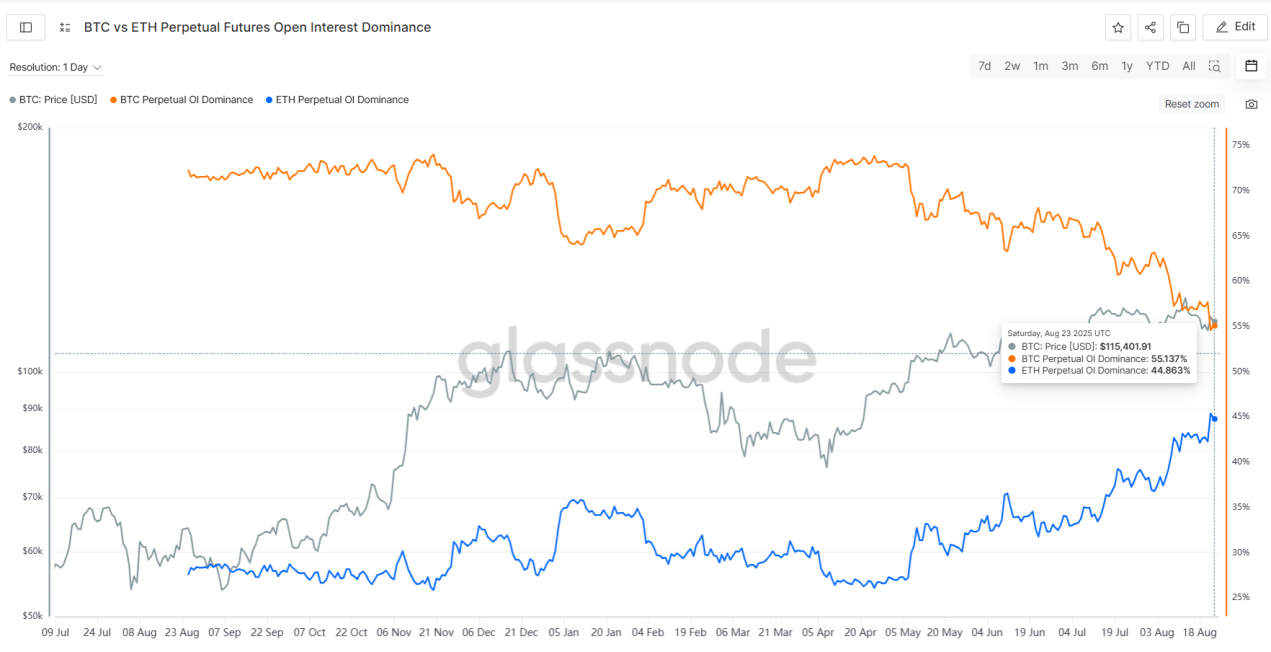
In terms of contract trading volume, the proportion of BTC’s trading volume has dropped from 61% in early May to 31% now; the proportion of ETH’s trading volume has increased from 35% in early May to 68% now, and the proportion has continued to increase.
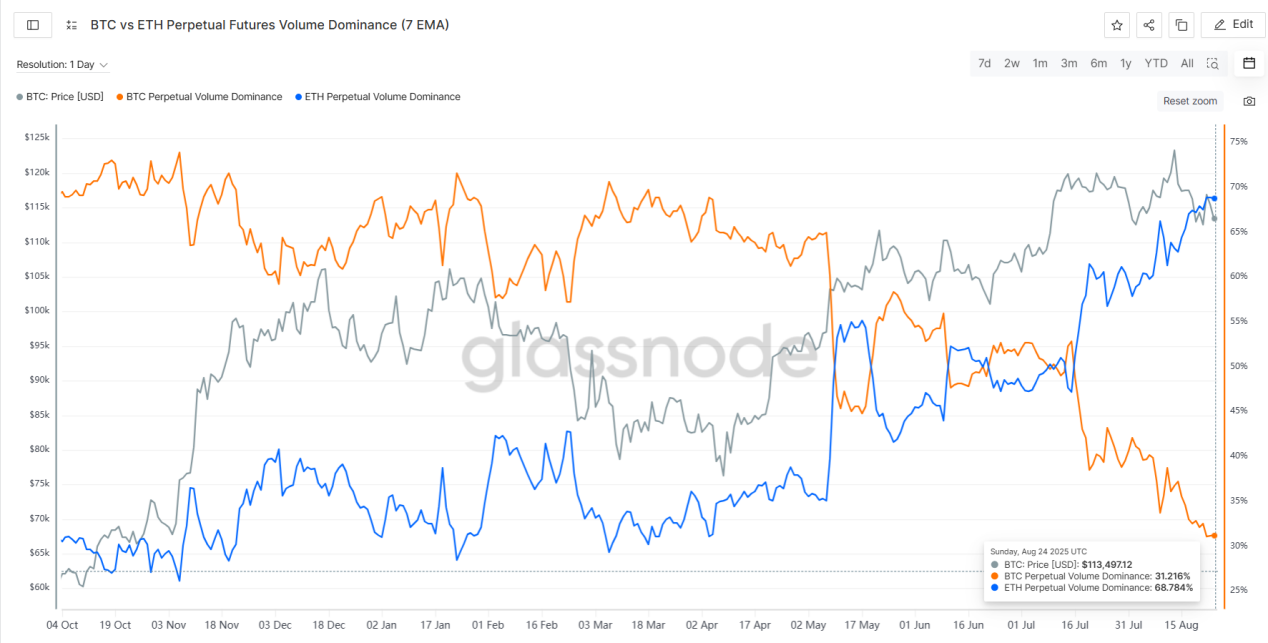
Judging from the recent behavior of giant whales on the chain, there is currently a wind deflection behavior on the chain selling BTC and buying ETH.According to @ai_9684xtpa data, starting from August 20, a sleepy BTC ancient giant whale sold part of its BTC, and exchanged 71,108 ETH (valued at approximately US$304 million) on spot, with an average cost of approximately US$4,284/ETH.The total holdings later increased to 105,599 ETH (worth approximately US$495 million).At the same time, ETH long order was built on Hyperliquid, and pledged 269,485 ETH (worth $1.25 billion) to the ETH beacon chain on August 25, directly surpassing the Ethereum Foundation’s holdings (231,000 pieces).
During the Q2 2025 period, the on-chain Ethereum Whale (wallets holding 10,000 to 100,000 ETH) increased its holdings of 200,000 ETH ($515 million) in the second quarter of 2025, while the total amount of ETH held by Super Whale (who holds over 100,000 ETH) has rebounded to more than 41.06 million ETH from its all-time low of 37.56 million ETH in October 2024, up 9.31% since October 2024.

3. The BTC chip structure is still relatively stable
BTC has performed relatively weakly recently due to wind deflection from BTC to ETH.From the perspective of ETFs, there is a large net outflow; from the perspective of giant whales on the chain, a large number of giant whales have appeared to change BTC to ETH.Judging from the past experience of the four-year cycle in the currency circle, this bull market will reach a length of time equivalent to the previous bull market in 2-3 months.Therefore, there are concerns in the market: whether BTC is about to start a bear market, and if BTC enters a bear market, how can ETH be able to survive and get out of an independent rising market?
We believe that the current fiscal cycle in the United States has been extended compared with the previous two rounds of crypto bull markets, and at the same time, the chip structure of BTC is still relatively stable and is now in a volatile state.

The following figure is a schematic diagram of the cost distribution of BTC chips. The gray column is the current price, and the blue box is the current main chip concentration areas, namely 93K-98K, 103K-108K, and 116K-118K.The accumulated amount of chips in these three areas is huge, and a large number of low-cost chips have completed the turnover in this range, thus forming relatively strong support.
Currently, the chips of 116K-118K are in a slightly loss state, while the chips in the two ranges of 103K-108K are in a profit state.Although BTC price performance is relatively weak at present, it has fallen to around 11K to gain support, and there are still two larger support areas below, and the overall situation is in a volatile state.
In addition, the current short-term holding cost is approximately 108,800.When BTC is running above this position, short-term holders are still profitable overall and there will be no panic selling.Looking back at history, we can see that there was a rebound in the early 2024 when short-term holders’ holdings’ cost line, and there were also cases where the cost line fell below the first time it touched in February 2025.If it falls below this cost line, BTC will enter a medium-term adjustment, which will affect the overall trend of the crypto industry.
Currently, BTC is in a critical position, and rebounded after hitting the cost line yesterday.This week, we should pay close attention to whether BTC can stabilize at this position.
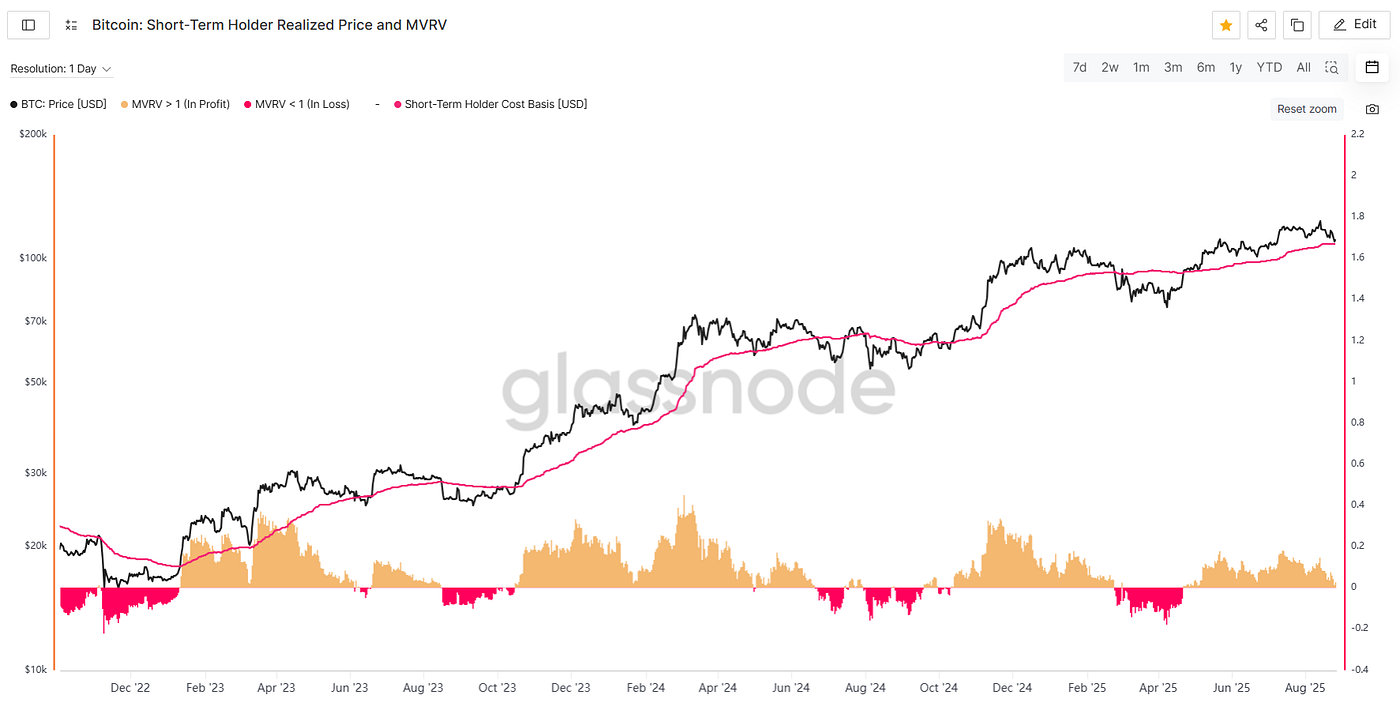
4. A continuous improvement of macro environment
1. Reshaping of fundamental valuation logic under US regulations
In July 2025, the GENIUS stablecoin bill was officially legislated. Compared with BTC, stablecoins anchor the US dollar 1:1, making it more suitable as a debt-reducing tool.At the same time, stablecoins can promote efficient flow of global capital into the US dollar system, support the purchase of US Treasury bonds and the liquidity injection of on-chain financial assets, and promote the digital expansion of US dollar hegemony.Currently, the total market value of stablecoins is US$275 billion, while BTC is US$2.2 trillion, BTC’s global mining machine value is estimated to be 15-20 billion, ETH’s market value is 550 billion, and the pledge value is about 165 billion.In the future, whether it is to replace BTC’s partial debt function, promote the coverage of asset value, or accommodate a new payment system, the scale of stablecoins will accelerate its expansion in the long run and grow rapidly to the market size of trillions of dollars.
As the main infrastructure place for stablecoins and DeFi, ETH benefits from ETH purchases made for financial chain-on-chain network security on the one hand, and will also benefit from the endogenous DeFi model: stablecoins inject basic liquidity – the DeFi ecosystem uses stablecoins to create leverage and derivatives to buy more ETH – the surge in trading activities drives Gas fees and promotes ETH burning.Through the transaction fees (Gas fees) and proof of stake (PoS) of the ETH network as cash flow income, a cash flow discount (DCF) model was introduced for rough valuation trial. Under optimistic conditions (7% growth rate, 9% discount rate, leverage factor 3), the ETH market value has the potential to exceed US$3 trillion, exceeding the current BTC market value.
2. The interest rate cut cycle is coming
On August 22, Powell delivered a speech at the Jackson Hole meeting, saying that inflation is still high, but the downward risk of employment is rising; while the policy is still in the “restrictive” range, the committee will “advance cautiously” and adjust its policy position if necessary.Analysts generally believe that the rate cut in September is almost “a foregone conclusion” and represents a dovish turning point.After the speech is released,
Crypto-related stocks and ETH-related targets rose sharply, and ETH retracted all the declines at the beginning of the week and rushed to a record high of 4887.
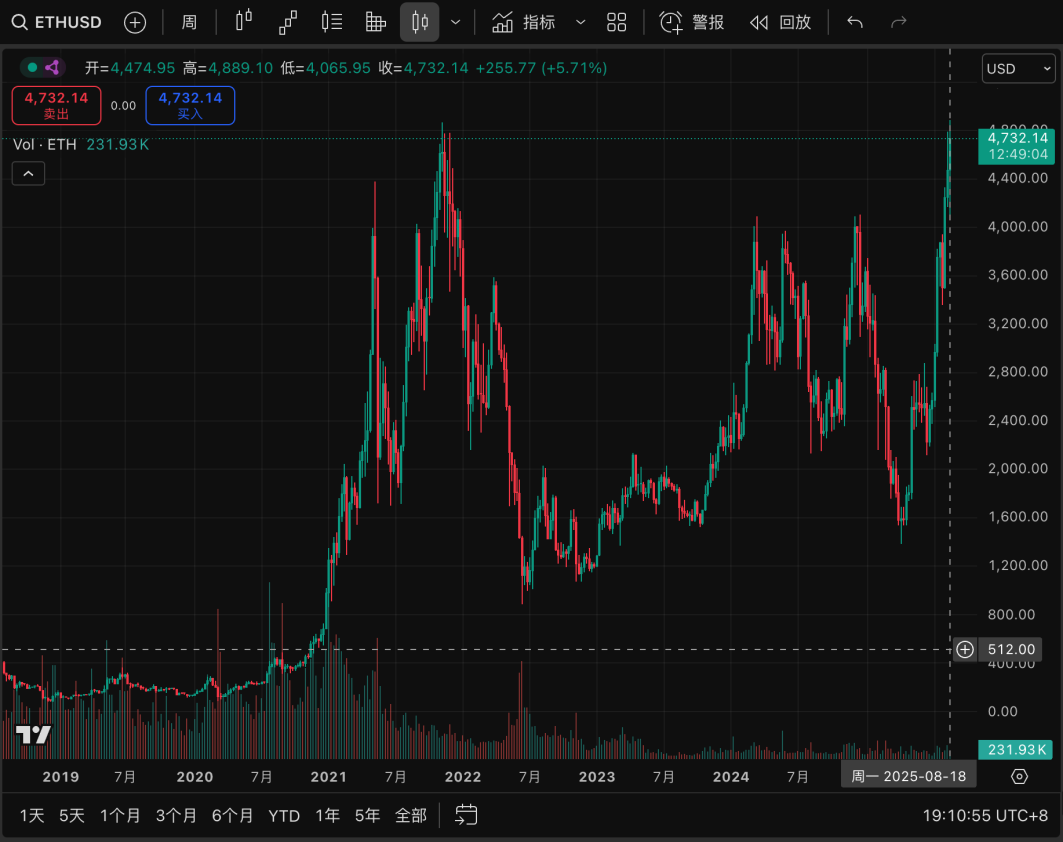
In the past interest rate cut cycle, ETH’s performance has generally been better than BTC. With members of parliament returning to Congress after their holidays in September, the promotion of crypto policies will be rapidly promoted. ETH’s financial on-chain and DeFi boom expectations have not yet been implemented, providing a positive macro environment for the ETH market.
3. The first choice for the development of stablecoins and RWA
The pace of US government and financial institutions promoting financial chains is very sustainable. Currently, the scale of stablecoins reaches US$275 billion and the RWA scale is US$26.4 billion. Among them, 50%+ of stablecoins operate on the Ethereum network, RWA accounts for 53.4% of Ethereum, and the total DeFi TVL1611, 60%+ is deployed on ETH.95% of Ryder BUIDL funds are deployed on Ethereum, and 80% of the Securitize tokenization share is deployed on Ethereum.
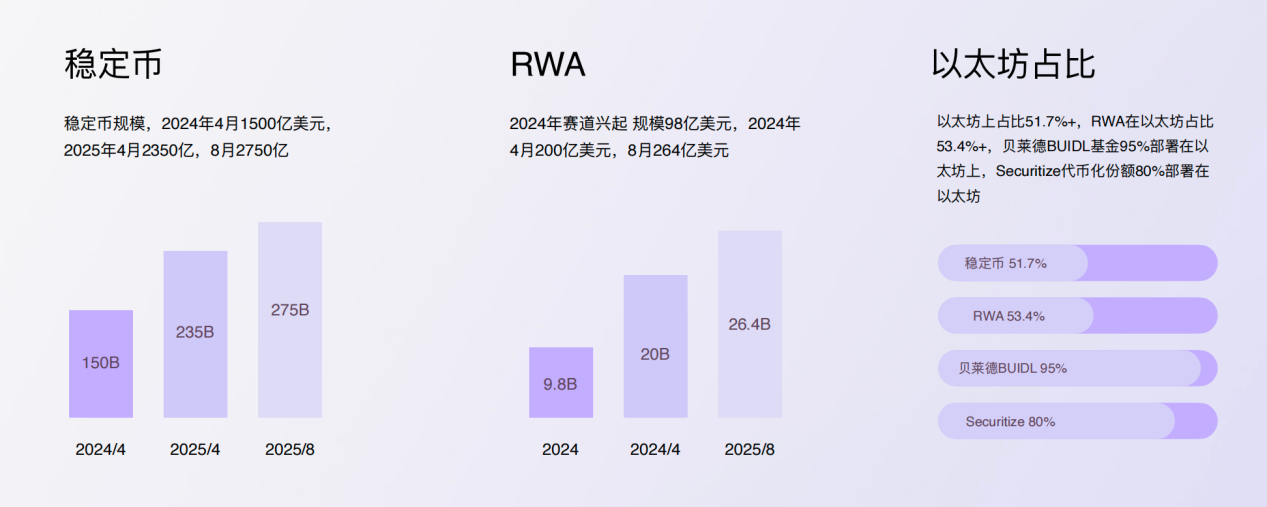
In this article, we tracked some data with clear quantitative and large scale for analysis.Overall, the recent supply-side unstaking data will not change the upward trend of ETH. The foreseeable upper limit of new buying volumes of both treasury companies and ETFs on the demand side is far from reaching, and the cost of building positions is relatively high.With the fundamental financial logic changes under US regulations, ETH also has assets that promote price increases with internal and external growth. With the improvement of the macro environment and the further development of policies, the long-term ETH market value will surpass BTC.




